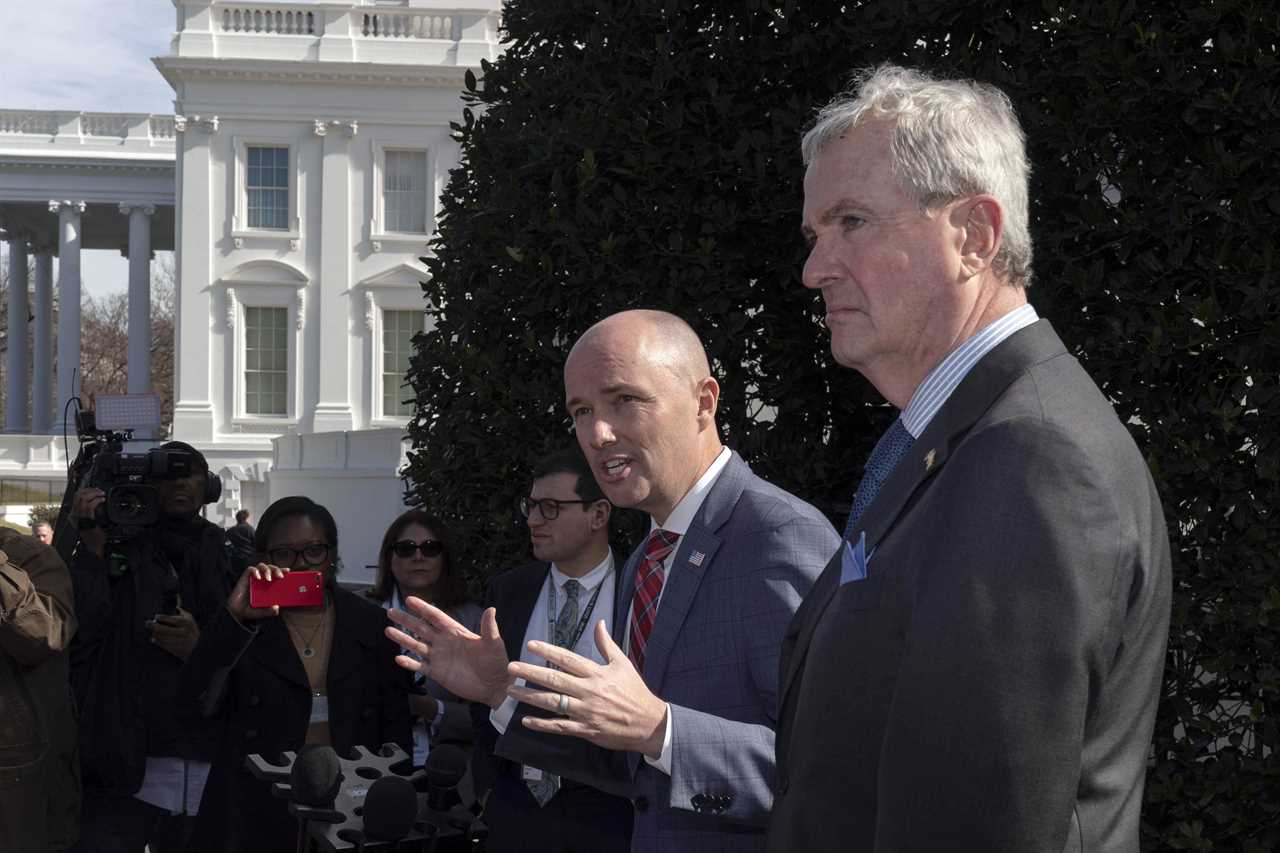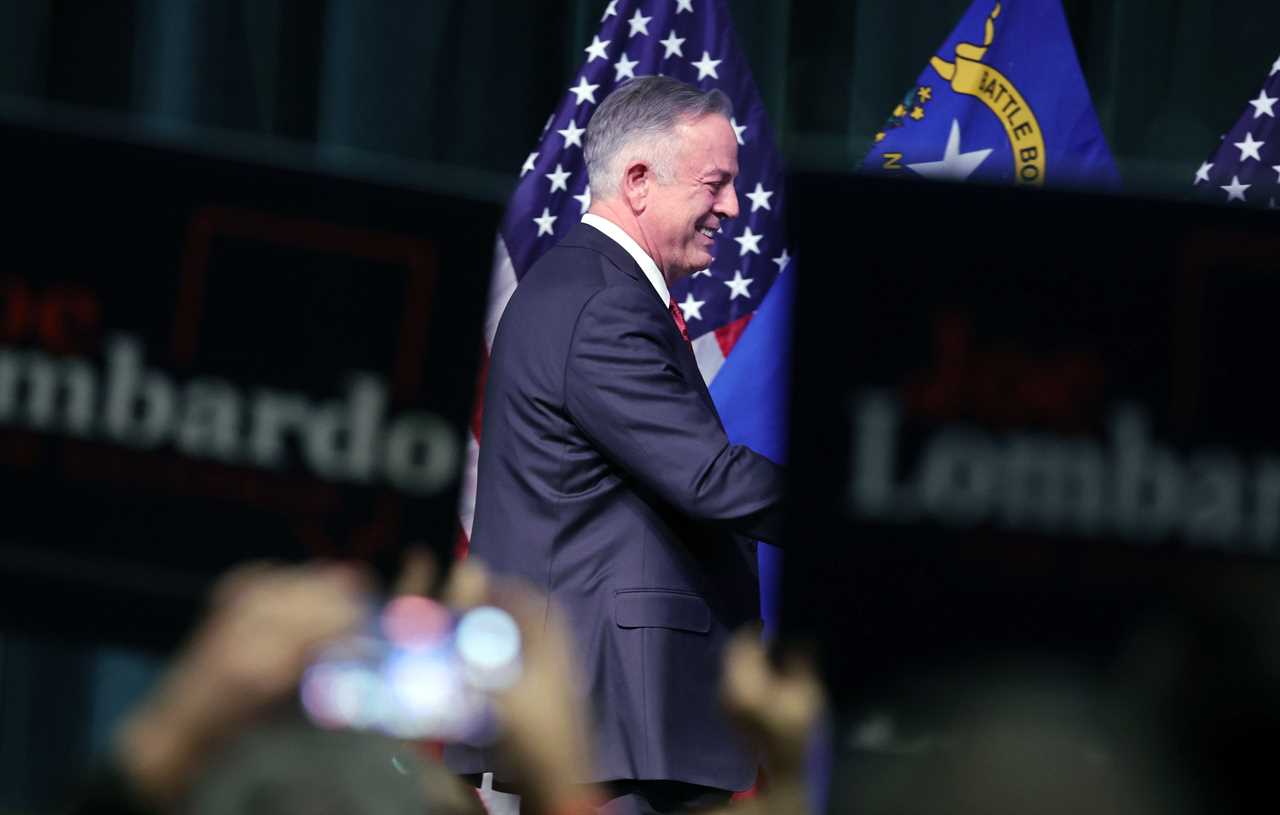
ATLANTIC CITY, N.J. — There are 26 Republican governors. Three of them showed up here this week at the annual summer meeting of the National Governors Association.
And of those three, one left after the first night, and another had little choice but to attend — his chairship of the group began at the conclusion of this year’s gathering.
Striding the Hard Rock Cafe casino stage like a megachurch pastor, Utah Gov. Spencer Cox used his maiden speech as NGA chair to implore his fellow governors to make the organization a model of robust yet civil debate.
“If we’re ever going to find our better angels again, it has to start with us setting the example of how to disagree better,” Cox said.
But it’s hard to do much disagreeing, or have a conversation at all, when nobody is listening: Fewer than a half-dozen governors were still in attendance for his remarks Friday, the session’s closing day, and they were all Democrats.
After more than a century of bringing together the nation’s governors, the NGA — long a wellspring of ideas, forum for best practices and platform for innovating policymaking — is at grave risk of falling victim to the silos plaguing most every other element of American politics.
That’s the bad news. The good news is if any governor can reverse or at least slow this trend, it’s Cox.
“A bipartisan organization in a partisan world is always going to struggle, there’s no question about that,” the earnest Utahan acknowledged in an interview before vowing to round up more Republicans for next summer’s meeting. “I’ll definitely be cajoling them next time.”
It won’t be easy.
Republicans and Democrats increasingly prefer to exist in separate political spheres rather than debate one another, let alone try to find consensus.
This sorting plays out on television, where right and left have their preferred cable networks and joint appearances between lawmakers or candidates on network shows are increasingly rare; it’s a way of life in Congress, where the parties have separate lunches and spend much of their free time raising money with their co-partisans; and of course, division is the mother’s milk of politics online, where algorithms push users toward the reinforcing content they crave.
Then there’s the fact that one of our two political parties has for seven years been in the grip of a demagogue who simultaneously benefits from and accelerates this polarization while driving Republicans further away from mainstream institutions.
Despite this descent, the NGA remained a vibrant if overshadowed bipartisan institution. I can recall attending the group’s summer meeting in 2017 and finding a robust turnout of governors from both parties.
At least for the chief executives, it was a storied association.
Besides the opportunities to learn from one another, and often poach a bit, the group’s meetings offered the governors attention from the media, business community and lobbyists that they couldn’t easily attract to Jefferson City or Montpelier. (Former Washington Gov. Gary Locke was thrilled to attend the meetings, he told people, because he knew the late Washington Post columnist David S. Broder would be in attendance.)
There’s the annual winter meeting in Washington, D.C., always paired with a White House dinner with the president, and the more casual and rotating summer conclave. Particularly for new governors or those with little national profile, these were must-attend events — a way to sell their state, their story and themselves.
Chairing the NGA offered even more visibility, luring ambitious governors like Tennessee’s Lamar Alexander, Arkansas’s Bill Clinton and Minnesota’s Tim Pawlenty to take control of the group and bolster their profile ahead of future presidential bids.
Governors were the White House farm team, and the NGA had convening power. Every president from Jimmy Carter up until Barack Obama ran a state except for George H. W. Bush, who grasped their significance enough to organize a historic education summit with the governors in his first year in office.
There was occasional partisanship at the meetings, but the preferred pastime of the governors was to gang up on Washington, critiques which would invariably include references to how they, unlike the Congress, had to balance their state budgets and just as inevitable paeans to the states as laboratories of democracy (hat tip: Louis Brandeis).
Republican participation has slowly tailed off, though. A few conservative states, like Florida and Texas, stopped participating in the association at all, no matter their governor.
Then, in the Trump years, some Republican governors stopped coming or sequestered themselves while in attendance because they didn’t want to face questions from the press about the president’s latest eruption. (The GOP executives needn’t have much worried this year — I didn’t see another national journalist, and there were few cameras besides C-SPAN.)
Since 2018, there’s been a turnover in states that has left both fewer Republican governors and fewer Republican governors of the sort who want to discuss best practices or share a soft-serve cone or bumper car on the boardwalk with their Democratic counterparts.
Blue-state Republicans such as Maryland’s Larry Hogan and Massachusetts’s Charlie Baker have been replaced by Democrats, and many purple states have elected or reelected Democrats.
In some states, where new Republicans have taken office, governors like Nevada’s Joe Lombardo have appeared reluctant to participate in the NGA. At last month’s Western Governors Association conference in Colorado, Lombardo told people he thought the NGA was a Democratic-leaning group, according to a source familiar with the conversation.
A Lombardo representative said he didn’t come to the NGA because of scheduling issues, but he and other Republican governors almost always find time to attend events hosted by the Republican Governors Association, which is dedicated to electing the party’s governors.

Fittingly for this polarized moment, it’s the RGA that has become the preferred organization for most GOP governors. That’s why the winter gathering of governors is usually well-attended across party lines: In addition to the White House invite, there are always ancillary fundraising events in Washington that ensure donors and therefore a good turnout.
Now, to be sure: Natural disasters kept some governors away this year. Others found the Eastern Seaboard location (with no major airport nearby) forbidding, and there was also a dip in turnout from some Democratic governors, if not nearly as significant as with Republicans.
Minnesota Gov. Tim Walz, a Democrat, told me he thought some Republicans stayed away for the same reason they did during Trump’s administration: “I don’t think they want you to ask them about the former president.”
Walz pointed out that the two governors staying for the conference didn’t need to worry about that: Cox has been clear about his distaste for Trump, and Oklahoma Gov. Kevin Stitt is already supporting Florida Gov. Ron DeSantis.
But what I found alarming was the talk racing through the hallways of the Hard Rock (which, in a reminder that Trump can never be fully escaped, was formerly his Taj Mahal): The NGA’s summer meeting may come to an end, replaced by only regional meetings that would likely reflect the partisanship of the region. That may be a safer space, to borrow a phrase, but it would be tantamount to surrender, a concession that even with governors the partisan chasm is just too deep to sustain a national organization.
This all may sound like so much nostalgia for a bygone day. Yet many of the governors do stand apart from their counterparts in Congress for their seriousness of purpose, their executive leadership in the face of crisis and, yes, their willingness to forge coalitions across party lines.
“It’s one of the more unique organizations where folks across the aisle can find common ground,” as New Jersey Gov. Phil Murphy, the outgoing NGA chair, put it.
The Democrat Murphy and Republican Cox, who spent the last year as vice chair, offered an example of the productive work that can be done by the group, as they and their wives spent much of their time together addressing the country’s youth mental health crisis.
The paltry turnout here may prove ominous, or it may be altogether fitting for the “Disagree Better” initiative of Cox, who in the days before the conference toured Gettysburg, Independence Hall and Valley Forge.
He wants to use his chairship to address precisely what the NGA has fallen victim to, the polarization fracturing the country. Cox is quick to say he’s not interested in one more call for civility — he wants to encourage debate and even argument if it’s substantive and means bringing people with opposing views out of their silos.
Yes, he knows he’ll be making this push into the headwinds of a presidential year — that’s the point.
“Over the next year my goal is to create counter-programming to the ’24 election,” Cox told me.
A 48-year-old attorney who fended off former Gov. Jon Huntsman, Utah royalty, and a conservative former House speaker on his way to the governorship in 2020, Cox has embraced an optimistic, center-right brand of politics that has little currency in today’s GOP.
That’s made him one of the most interesting if least known political figures in the country. He’s not railing against Bud Light, he’s trying to forge consensus for a new state flag.
Cox’s approach has already caught the eye of the new roster of governors elected last year. Pennsylvania Gov. Josh Shapiro, a Democrat, called him “one of the most thoughtful governors, who I routinely look to for new ideas and new approaches.”
It helps that Cox is staying out of the presidential fray and seeking reelection next year.
He’s all too aware the White House race will consume attention and, fittingly, when he delivered his Friday remarks much of the political press was fixated on a presidential candidate forum taking place at the same time in Iowa.
Yet Cox said he thinks the focus on Trump “also gives us an opportunity because there’s a lot of people out there, looking, searching for anything and asking: ‘Is there something else out there?’”
His opening gambit: a dining room table video with his NGA vice chair, Democratic Colorado Gov. Jared Polis, which promises to share tips about how to confront “your MAGA uncle” or “your woke niece.” Cox and Polis are eager to set off on an odd couple roadshow, the former Mormon missionary from rural Utah and gay multimillionaire from Boulder. PR tactics aside, they also want to tip into research on depolarization so their effort is “not just touchy-feely, but behavioral science driven,” as Cox put it.
He doesn’t seem terribly concerned about a primary threat from the right at home, but then again he’s uniquely positioned to lead this effort hailing from a state that’s both reliably Republican and inherently uneasy with grievance politics (Mormons know from scapegoating and persecution).
Still, I couldn’t help but ask Cox if he ever feels he was born 20 years too late, if he would have been more at home politically in the era of one his predecessors as governor, and another NGA chair, the consensus-oriented Michael Leavitt.
Just the opposite, he said.
Polarization and the risk it poses are “the challenge of our day,” said Cox.
Recalling his recent tour of Pennsylvania’s historic sites, he invoked George Washington’s prescience.
“Holding the republic together is the key for us right now,” he told me. “This is the stuff he warned against, factions and partisanship.”
He knows, he conceded, “it sounds like hyperbole. But I really think we’re talking the 1850s all over again, and we need statesmen and women who are willing to do something different.”
----------------------------------------
By: Jonathan Martin
Title: No-Show Republicans Shun NGA
Sourced From: www.politico.com/news/magazine/2023/07/16/no-show-republicans-shun-nga-00106480
Published Date: Sun, 16 Jul 2023 06:00:00 EST
Did you miss our previous article...
https://consumernewsnetwork.com/politics-us/bronze-age-pervert-the-man-behind-it






